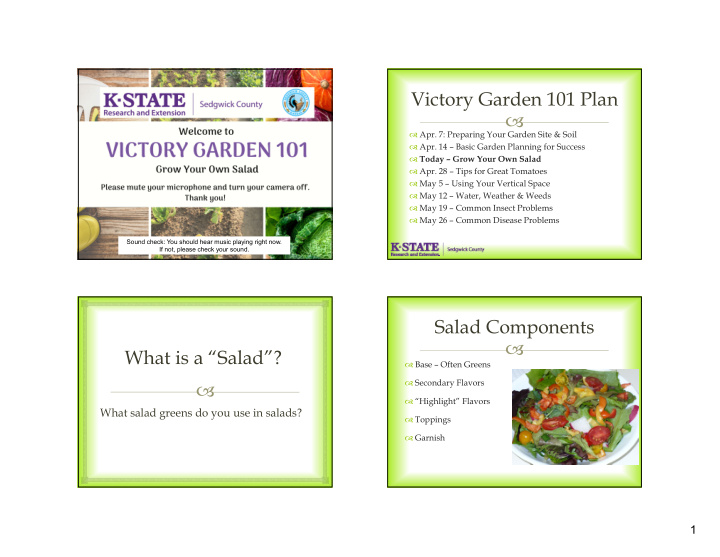



Victory Garden 101 Plan Apr. 7: Preparing Your Garden Site & Soil Apr. 14 – Basic Garden Planning for Success Today – Grow Your Own Salad Apr. 28 – Tips for Great Tomatoes May 5 – Using Your Vertical Space May 12 – Water, Weather & Weeds May 19 – Common Insect Problems May 26 – Common Disease Problems Sound check: You should hear music playing right now. If not, please check your sound. Salad Components What is a “Salad”? Base – Often Greens Secondary Flavors “Highlight” Flavors What salad greens do you use in salads? Toppings Garnish 1
Salad Components Getting Started with Salads Flavor Consider Your Space Separate garden area Color In your landscape Indoors? Texture Leaf Size What time of year do you want greens? Choosing Salad Greens Considerations for Variety Selection How much? Days to maturity What size? Cold hardiness Heat tolerance How often? Bolt resistance Disease resistance What colors and Flavor flavors? Type of lettuce, spinach, kale, etc. – MANY choices! 2
Microgreens Leafy Greens Very young seedlings Cool Season Warm Season Lettuces Amaranth Takes a lot of seed Spinach Goosefoot Chicories New Zealand Easy to grow Spinach Arugula Orach Brassicas / Asian greens Malabar Spinach Sorrels Swiss Chard Corn Salad Growing Cool Season Greens Seed and Reseed Plan continuous plantings Planting Time Late March to early April Once per week Once every 2 weeks Mid-August to mid-September One time only Succession Plantings Transplant for earlier harvests 3
Growing Cool Season Greens Growing Cool Season Greens Soil & Fertility Seeding Depth and Spacing Well-drained Microgreens – plant thickly Medium sized greens – 2-4” Neither too sandy nor too heavy “Baby” size greens – 6-8” Balanced soil fertility Full sized greens - >8” Low-analysis fertilizer Plant thicker and thin the planting Add compost Growing Cool Season Greens Growing Cool Season Greens IT BOLTED!!! Now Water Needs what? 1 - 1.5” per week Eat the blooms in salad or stir-fry Water thoroughly rather than lightly Pull it up, and replant later. Wilt quickly but can recover Slow-bolting varieties 4
Cool Greens in a Hot Summer Growing Warm Season Greens Find heat or bolt resistant types Planting Time After soil is warm Swiss Chard Soil & Fertility Arugula Water Needs Kale Seeding Depth and Spacing Light Shade Plenty of Water Insect Challenges Disease Challenges Aphids Leaf Spots Fixed coppers Spider Mites Read and follow Chewing Insects label Population/damage Tipburn level Too hot! Soaps & oils Adequate watering will help Wash them off 5
Harvest Time Storage and Food Safety What size? Wash Whole plant or just the leaves? Dry Cool quickly Store in a bag Lettuces Sweet & bitter types Many colors Specific Leafy Greens Main types: Crisphead Romaine Bibb/Butterhead Leaf Oakleaf 6
Spinach Mustards Traditional spinach “Mess of greens” Smooth or savoyed leaves Hot and spicy or mild and sweet Look for slow-bolting Reds and greens Flat, curled, or lobed leaves Bok Choy Mizuna AKA Pac Choi, Pak Choi, etc. Toothed leaves reminiscent of oak Very popular Chinese green leaves Dark green leaves w/white stems Sweet with a mild mustard taste Red leaves with green stems Common in mixes 7
Cabbage & Kale Beet Greens & Swiss Chard Dark green leaves Many colors, shapes with colored veins Best for salads when Earthy and sweet beet young and tender flavor Sharp, strong flavor Best for salad when smaller Very hardy Arugula Radish Heart-shaped cotyledon AKA Rocket, Rucola leaves Lobed full-size leaves Strongly flavored Colored stems Spicy radish flavor Rich and peppery Use any radish seed for Slightly to deeply microgreens lobed leaves Leaf Radish varieties Used at all sizes 8
Peas Frisee & Other Chicories Highly curled and Tendrils and leaves frilled green leaves Fresh pea taste Sometimes the centers are blanched Grow quickly Bitter greens Best used when 4-6” Chicory, Puntarelle, Radicchio, Endive, Escarole Mesclun Mixes Warm Season Greens Available from various WE MUST FIND WE MUST FIND seed companies Amaranths Lettuce blends A A Goosefoot Spicy blends New Zealand Spinach REPL REPLACEMENT ACEMENT Mild blends Orach FOR SPINACH!!! FOR SPINACH!!! Malabar Spinach 9
Amaranth Goosefoot Great source of vitamins and Green and purple minerals varieties Spinachy taste Looks like Lamb’s Quarter Various colors St. Joseph’s coat Burgundy Orach – Red Orach New Zealand Spinach Green or purple Native to the Southern leaves, serrate Hemisphere margins Thick, fleshy leaves Highly ornamental when mature Spinach taste Spinach taste 10
Malabar Spinach A Few Saladish Root Vigorous vine Veggies Succulent and juicy Highly heat tolerant Carrots Carrot Variety Considerations Earliness/Days to Maturity Cold Tolerance & Overwintering Flavor Root Shape (soil type) Color Vigor & Strength of Tops Bolting in Heat 11
Beet Variety Considerations Tips & Tricks for Carrots Monogerm Seed? Consistent Soil Moisture for Germination & Growth Color Radishes to Mark Rows? Shape Thin to Ideal Spacing Germination/Seedling Vigor Grow Short Carrots in Clay Soils Storage Characteristics Add Organic Matter Quality of Greens Mulch Tips & Tricks for Beets Radishes Thin to Appropriate Spacing Spring Fall 25-40 DTM 50-60 DTM Eat the Thinnings! Red, White, Pink, Purple, Daikon, Round types Mulch Yellow, Bicolor Good for Long Storage Keep Weeds Out Hotter with Heat/Stress Don’t Disturb Roots Plenty of Phosphorus Boron? 12
Turnips Kohlrabi Seed or Transplant Very Cold Hardy Spring & Fall plantings Better Flavor in Colder Weather Usually eaten raw Good for Long Storage Waxy leaf like broccoli Thin to Desired Spacing Soil Temp – 40 degrees Questions? Social Media For More Information: Facebook Page: Master Gardener Hotline http://facebook.com/sedgwickextension sgemghotline@gmail.com - preferred 316-660-0190 M-F, 9-12 and 1-4 Instagram: @ksresedgwickco Walk-In Clinic (not right now, but eventually) Extension E-Newsletter The Demo Garden blog: Text: EXTENSION to 42828 Horticulture Information Center: http://thedemogarden.org http://hnr.k-state.edu/extension/info-center/ 13
Recommend
More recommend